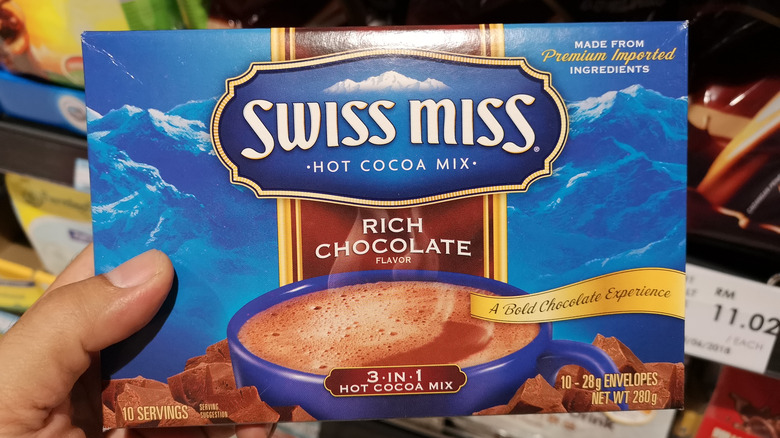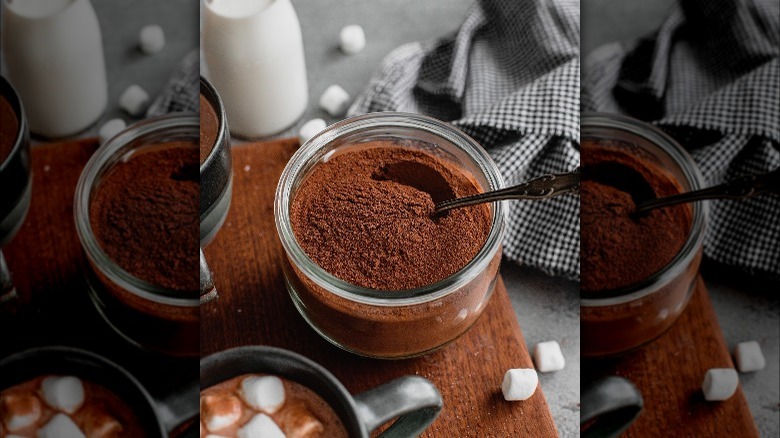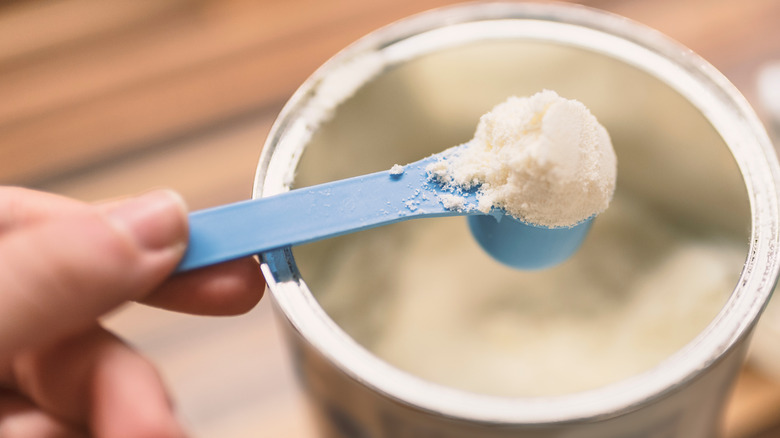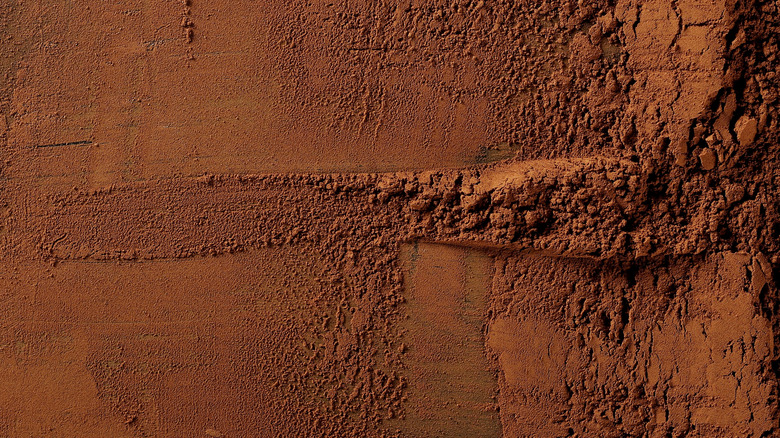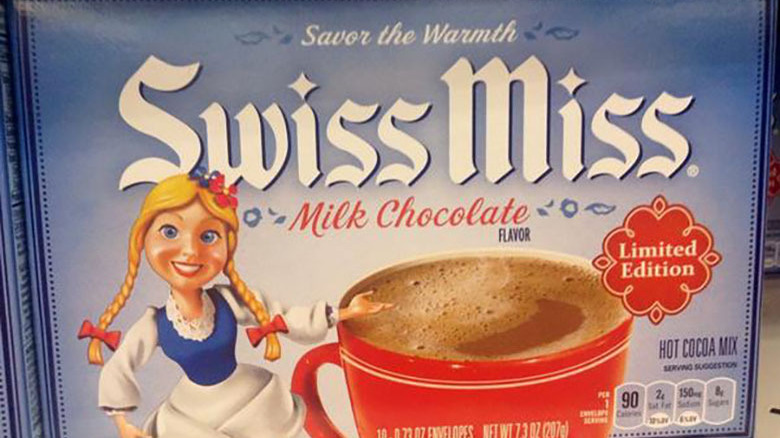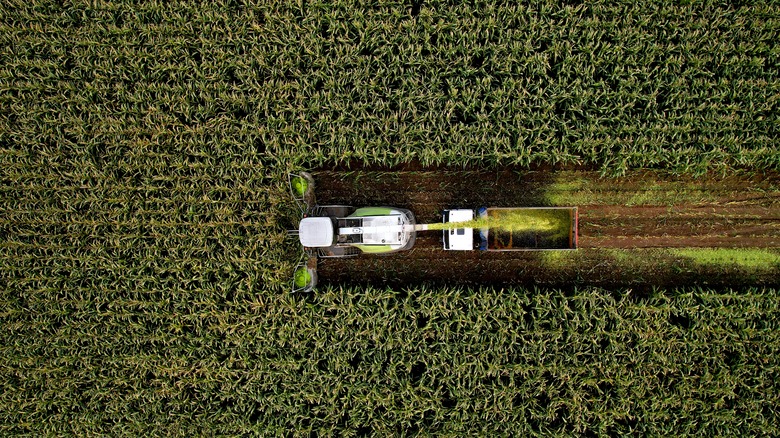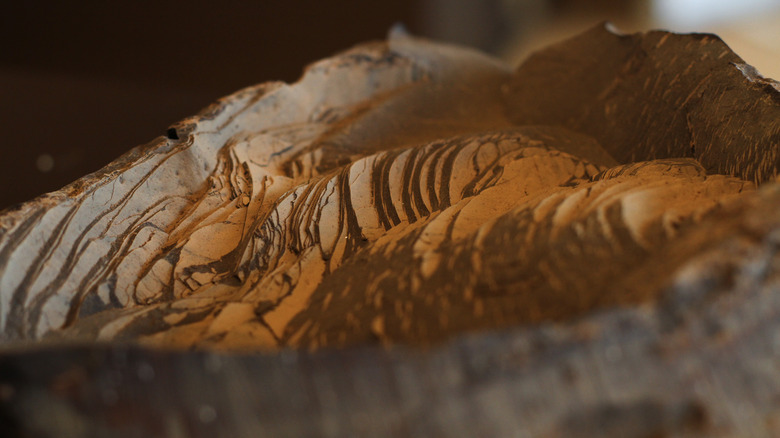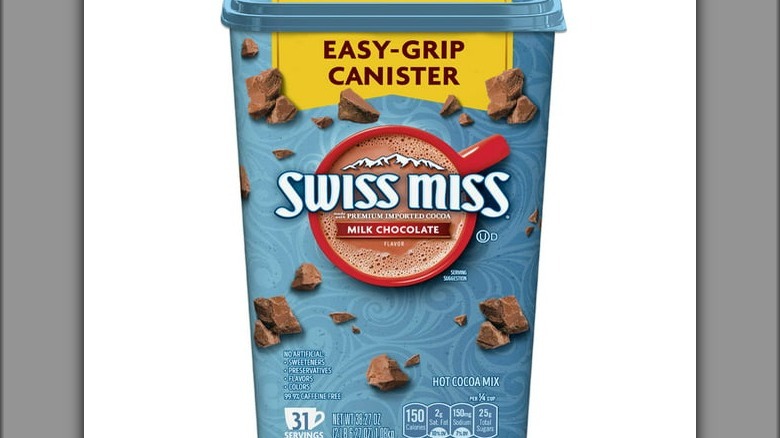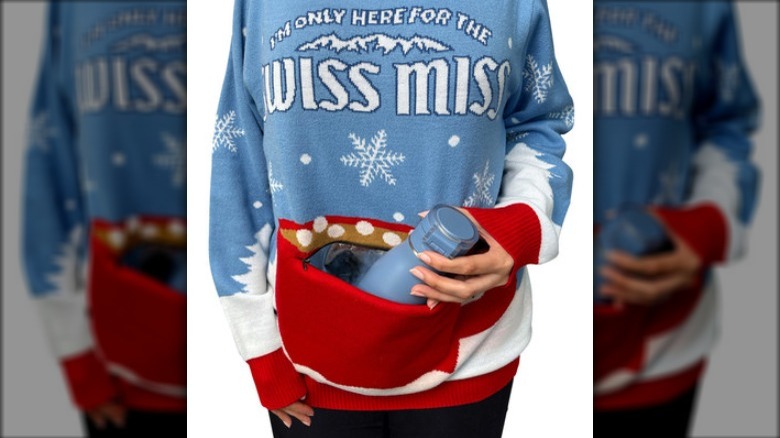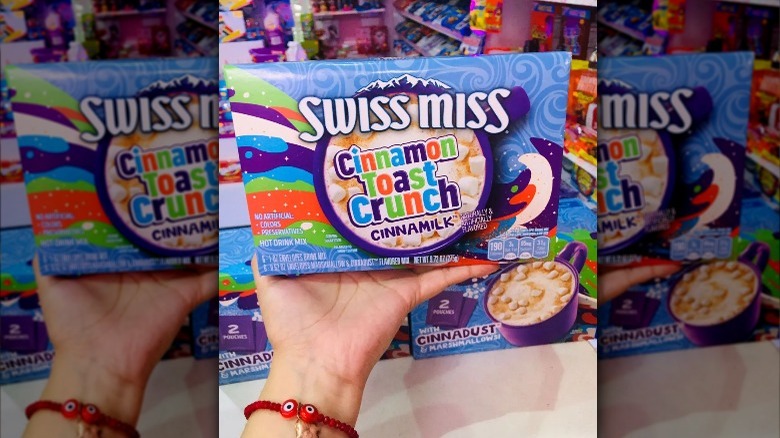Swiss Miss: 11 Facts About The Hot Cocoa Mix
Perhaps one of the sweetest childhood memories is enjoying a warm cup of cocoa (or hot chocolate, if you prefer) in the winter, the simple drink is a wonderful respite from the cold outside. This treat, however, is maybe not as childish as it first may appear. YouGovAmerica concluded in 2020 that adult Americans still loved the winter drink just as much! The survey of 1,000 Americans over the age of 21 found that hot cocoa ranked as the supreme winter drink. It's not hard to understand why, after all, hot chocolate is a cup of comfort and nostalgia all in one.
But, it's not different types of cocoa that we're sipping on. Compared to how other cultures drink hot chocolate, U.S. residents are likely to enjoy their cocoa from a cocoa mix (via MSNBC). These cocoa mixes are typically a mix of cacao powder with dehydrated milk and sugars, and all they need is a bit of hot water to enjoy. While these mixes may seem like an age-old way to enjoy cocoa, they're completely modern. In fact, we can credit the invention of the modern hot cocoa mix to one man: Charles Sanna, the American creator of Swiss Miss. Indeed, the first of many surprises is that Swiss Miss, isn't even Swiss at all.
1. Charles Sanna is credited with inventing the mix
Charles Sanna is credited with pioneering the modern cocoa mix. But, interesting to note is that he didn't start off as a confectioner. A profile in The Washington Post noted that although Sanna's family owned a considerably large dairy company in Wisconsin, he first had no intention of joining the family business.
He studied mechanical engineering and in 1939 enlisted in the Navy to help with submarine war efforts. After victory was declared, Sanna wanted to by all means, according to The Smithsonian Magazine, continue as a private engineer. But, with some encouragement, or perhaps some pressure, joined the family business.
At first glance, it may have seemed like Sanna might have been too industrious for the dairy industry and better suited for war than the boardroom. But, it didn't take too long to see why the family wanted him in business. Sanna not only showed business skills, but sharp forward-thinking (via The New York Times).
But, it wasn't all labor for him! As noted by the Post, the man had quite a sense of taste. His daughter claimed, that he could take the tiniest piece of cookie and note that the flavor was off because the nuts were spoiled. That has to be at least a key to the magic the man would create and the culinary prowess that ultimately brought the brand to major recognition.
2. The history of the mix started with the Korean War
Similar to Sanna, the brand that later came to encompass Swiss Miss didn't start off so sweet. Before WWII, the family-owned business focused primarily on milk and dry industrial dairy products according to Saco Foods. But, as Charles Sanna joined the company, things quickly saw a shift to a larger scale, as outlined by The New York Times. By the '50s, Sanna had both engineered and produced dried milk, which would be marketed as Sanalac (via Saco Foods and The New York Times). This product was, as per the Times, the first of its kind. Undoubtedly it provided the groundwork for the later cocoa mix.
By the start of the Korean War, Sanna Dairy Engineers provided rations to the troops. The Wisconsin-based dairy company had devised a creamer for the soldiers overseas that had a long shelf-life and was easily transportable according to Grub Street. During the war, the Army had an established contract with the creamery. This agreement stipulated that Sanna Creameries would provide a certain amount of powdered creamer regularly (via The Washington Post). If this wasn't fulfilled, the company would face fines. To stay prepared, the company overproduced consistently. But with the war over, the company had a lot of product on its hands! But, as the saying goes, waste not want not. The Korean War proved indirectly pivotal not only for the Sanna company, but for American cuisine as a whole.
3. Sanna went on to create the first instant cocoa mix with surplus product
With a major surplus on their hands, the Sanna Dairy Engineers were in a position where they could lose a lot if they weren't able to offload their product. But, by all accounts, Charles Sanna was a creative man and according to his Legacy.com obituary, he soon got to work in his personal kitchen with an idea in mind.
The obituary notes that he began experimenting with different mixes, and wanted to find the perfect blend for a great cup of hot chocolate. The Washington Post cites that Sanna turned to consulting the family cookbook to guide him through the recipe process. As he experimented with different ratios and ingredients in his personal kitchen, his kids were able to hold the ever-wonderful position as taste testers to make sure the recipe was truly perfection.
In the end, according to The Smithsonian, Sanna's original Swiss Miss recipe consisted of: powdered creamer, cocoa, sugar, and vanilla. With Sanna's mix, all that was needed, for the first time, was a bit of hot water to make a cup of cocoa. The Washington Post notes, that by the late '50s, Sanna had accomplished nothing less than a "culinary breakthrough." Considering the fact that Swiss Miss still lines grocery store shelves and there are dozens of instant cocoas on the market, this seems like an apt description.
4. The cocoa mix was originally served primarily on planes
It didn't take long for the new hot cocoa mix to take off, literally! Swiss Miss may feel like a grocery store staple, but according to our sources, the hot cocoa mix was first primarily served on airplanes (via Conagra Foods). The American Institute for American Research clarifies that there is some reasoning behind the somewhat out-of-left-field setting. The cocoa was offered to both airline companies and to the military, where whole milk would largely be unavailable according to the institute. Sanna's New York Times obituary also noted that certain restaurants were also given packets of the hot cocoa. Similar to the airplane situation, it's reported that customers would also walk off with extra packets of the drink mix! By all accounts, the company had a hit on its hands.
According to the research article, Sanna found that airplane cocoa orders specifically would need to be refilled very quickly, much more quickly than they should be. After a few calculations, he was an engineer after all, Sanna concluded that people had to be walking off with extra packets of cocoa! There was no other explanation for how often the cocoa needed to be replaced. It's a classic story of there being a hole in the market, and Sanna was more than ready to meet it! It wouldn't be long before what would become Swiss Miss hot cocoa would hit the markets for individual purchase.
5. It wasn't initially called Swiss Miss
Surprisingly, the instant hot cocoa mix wasn't always Swiss Miss! The brand was originally Brown Swiss, according to Pop Icon. Which, admittedly, doesn't quite have the same ring to it, but the site explains that the brown half of the name was supposed to refer to the cows used to make it. Of course, this is a bit ironic given that the Sanna Dairy Engineers used white and black Holstein dairy cows to make its products. In 1961, as the product hit the market, it was fully rebranded to Swiss Miss (via Smithsonian Magazine). It's no wonder that the Swiss half of the brand name was kept, after all, it is Swiss chocolate that has one best reputations in the chocolate world!
The first decade of the brand really leaned into the (faux) Swiss aspect of the brand, and the cocoa even had a person-like mascot, a young Swiss girl, i.e., the Swiss Miss pictured above. Featured with blonde pigtails and what should be traditional Swiss garb and surrounded by what should be Swiss motifs, the brand definitely leaned into a folksy European aesthetic. So wonderful has the marketing and branding been, that to some it may even come as a surprise that the company is fully American. While the Miss has maybe faded into obscurity in the 21st century, in 2012 Swiss Miss did offer throw-back packaging to offer some nostalgia for those who may want to yodel back to a childhood classic.
6. The instant cocoa was a favorite among Arctic explorers
Sometimes fans come from the most unexpected places. There's no better case and point than the fact that Swiss Miss came to be a favorite among Arctic explorers. Really, hot chocolate and Arctic exploration is nothing new. According to the Museum of Hot Chocolate, at least in modern times, whenever intrepid explorers would set out, they would do so after having a mug of cocoa. Granted, it seems counterintuitive that such rough-and-tumble expeditions would be accompanied by a frothy cup of cocoa. But, as per Antarctic Logistics, the sweet drinks were and are able to provide some comfort and energy on long and harrowing journeys. It stands true then, that cold weather is best met with a sweet drink!
Reports of hot cocoa-guided journeys in the Arctic go back to as early as 1827, by 1989 American arctic explorers embarked with Swiss Miss in tow (via the Museum of Hot Chocolate). In fact, the crew was so well stocked up, that they are reported to have drunk around 2,000 cups of Swiss Miss cocoa on their 4,000-mile journey.
7. To this day Swiss Miss is produced in Wisconsin
But, no matter how high the Swiss Miss hot cocoa brand has literally flown nor how many miles it has traveled across the Arctic, there is still a certain locality to the Swiss Miss brand. Not only is it still made in the U.S., but according to the company website, the company is still based in Wisconsin as well. This is pretty impressive, given that Sanna's father first founded his dairy company in 1935 (via Food Passages). Now almost 100 years later, the company still remains not only in the same region, but the same state.
Even though the Swiss Miss brand and recipe have long been sold to a larger conglomerate, Conagra Brands, there are some things that continue. Perhaps most importantly, according to Food Passages, is that the hot cocoa is still produced in Menomonie, Wisconsin in the original plant used by the Sanna family. While the production process has certainly been scaled up over the decades, where the hot cocoa mix originates hasn't changed a bit.
8. In 2019, the brand was hit with a lawsuit claiming it doesn't contain real cocoa
Swiss Miss has long relied on a once-squeaky clean image of being a family-owned brand, but it has not been without its scandals. In 2019, a class action lawsuit accused the company, very seriously, of false advertisement according to Top Class Actions. While certain Swiss Miss packages claim that the mix is made "With Real Cocoa" or "Simply Cocoa," the plaintiff claims that this is simply untrue. With a little research, the team found that the recipe really uses alkalized cocoa.
This may seem like a banal difference, but according to Top Class Actions, there's a large difference in quality. But, the difference is so pronounced that the website described alkalized cacao as "substantially inferior." As the name implies, alkalized cocoa is soaked in an alkali solution. According to the site, this not only changes the flavor, but removes other healthful properties that cocoa may contain.
According to the Class Action Organization the plaintiff also notes that the product is priced as if it were actual cocoa, when indeed, alkalized cacao is cheaper. It appears as if the lawsuit is still pending.
9. Swiss Miss is currently looking for a sustainable reinvention
Despite this controversy, the brand is still trying to reinvent itself and move in a more positive direction. One step forward is by redesigning its packaging. According to a Conagra press release in 2020, the conglomerate that currently owns the brand announced plans to completely redesign the cocoa's classic packaging.
The new 38-ounce container has been redesigned, according to the site, and is still made of plastic, albeit completely from recycled plastic. The canister has also been reformed to be a tub, which as outlined by the report, has reduced carbon footprint by 15%. This major reduction is because the shape is much more space efficient. While some may miss the classic blue canisters, the rectangular blue cubes may just be something new to grow fond of. As noted by the press release, the company aims to make 100% of its plastic packaging eco-friendly by 2025.
On the other hand, it begs the question in this current day and age if packaging rebrands are enough? For one, as noted in the press release, only the 38-ounce canisters are the ones that have been changed. Meanwhile, there is no word if other packages and, very importantly, the ingredients will also undergo a sustainable redesign. As it's been shown that sustainability is projected to be one of, if not the singular, most important factors in the cacao industry (via Bar Talks), it could be that Swiss Miss has a long way to go.
10. The brand wanted to design clothes with hot chocolate lovers in mind
Meanwhile, Swiss Miss has tried to reach out to hot chocolate lovers in an unconventional, yet surprisingly effective way. It may seem like each year, Christmas sweaters are getting uglier and uglier. And actually, they have! According to 3D Insider ugly Christmas sweaters have really come into trend. In the last 10 years, retailers like UglyChristmasSweater.com have racked up around 5 million USD in sales. From a place of irony, to a place of fondness, it could be that ugly Christmas sweaters have come to stay. Looking to pair up with other holiday traditions, in 2021 Swiss Miss dropped a collab with UglyChristmasSweater.com to give something sweet albeit tacky for the holidays. The Swiss Miss sweater evokes a sense of winter kitsch: A blue sky features falling snowflakes, with a red mug brimming with cocoa at the base of the sweater.
But, as Food & Wine points out: Food and fashion collabs aren't completely new, and they're starting to pop up more and more often. What sets the Swiss Miss sweater apart from the other trendy collabs, according to the food site, is that there's an air of functionality to it. That's because the sweater features an insulated pouch to store thermoses of hot cocoa in. This certainly puts new meaning to the term "frothy jumper"!
11. Swiss Miss has long had unexpected collaborations
But unexpected collaborations are nothing new for the Swiss Miss brand. It's fascinating to know that the brand with such a long history is still up to trying new things. Nothing shows this more than the different flavors and variations of Swiss Miss that are available on the market today. So, it should come as no surprise that a classic American giant would team up with other classic American brands. And what's better than a little bit of sweetness in the mornings, anyway?
For one, the Cinnamon Toast Crunch Cinnamilk combines all the best parts of hot chocolate with the incomparable Cinnamon Toast Crunch. While the drink doesn't have bits of Cinnamon Toast Crunch in it, it does have the Cinnamilk that tends to form at the bottom of the cereal bowl. A cinnamony twist with marshmallows and hot chocolate makes for an uber-comforting drink.
For those who prefer other breakfast cereals, the Swiss Miss and Lucky Charms collaboration will hit the spot. Similar to the Cinnamilk Hot Chocolate, the Lucky Charms Hot Chocolate focuses on the best part of the cereal: the marshmallows. The Swiss Miss Lucky Charms hot chocolate is a cozy drink that offers up two favorites in one mug.
